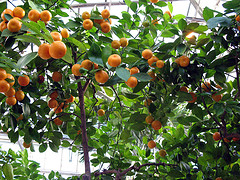Oranges
| Infobox on Oranges | |
|---|---|
| Example of Oranges |  |
| Freshness facts | |
| Optimum carrying temperature | 2°C to 7°C (dependent upon cultivar/origin) Some examples: Navel: Moroccan, Spanish, 2°C to 3°C Salustiana: Spanish, 2°C Valencia Late: Moroccan, Cyprus, 2°C to 3°C Spanish, 2°C South African, 4,5°C USA (California), 2°C to 7°C |
| Highest freezing point | -0,8°C |
| Acceptable product temp. at loading into containers | Max. 5°C above carrying temperature |
| Optimum humidity | 90% |
| Ventilation setting for containers | 25 m³/hr |
| Storage life | 2-3 months |
| Climacteric / non-climacteric | Non-climacteric |
| Ethylene production | Very Low |
| Ethylene sensitivity | Moderate |
| Modified / controlled atmosphere | 0%-5% CO2; 5%-10% O2 |
| Potential benefits | Low O2 delays senescence Elevated CO2 may reduce chilling injury symptoms in some cases |
| Availability | |
| Morocco Spain South Africa South America |
November - June October - July May - September June - November |
Oranges
Contents
Harvesting and handling
The sweet orange is perennial evergreen. Fruit shape varies from spherical to oblong and ranges from seedless (0 to 6 seeds) to seeded (> 6 seeds). Peel color at maturity ranges from light to deep orange but may remain green under warm conditions. Late season ‘Valencia’ oranges may turn from orange to green (re-green) under warm conditions. Sweet oranges are generally classified into one of four groups: 1) round oranges like ‘Valencia,’ ‘Hamlin,’ ‘Pineapple’ and ‘Shamouti’; 2) navel oranges like ‘Washington Navel’; 3) blood or pigmented oranges like ‘Moro’ and ‘Tarocco’; and 4) acidless oranges like ‘Succari.’ Like all other citrus fruits, oranges are non-climacteric with no postharvest ripening phase. A high quality orange is mature, with good color intensity that is uniformly distributed over the surface. Fruit must be firm with a fairly smooth texture and shape that is characteristic of the variety. Grade standards for sweet oranges are based on maturity, color intensity and uniformity, firmness, shape, size, smoothness, freedom from decay, as well as freedom from defects (bruises and abrasions), insects, fungal attack (eg., cake melanose), growth cracks, chemical burns, and physiological disorders.
Cooling and storage
Prompt cooling soon after harvest should be applied and optimum pulp temperatures should be reached within a few days from harvest.
The addition of fresh air is extremely important as citrus fruit can start to ferment within a few hours due to anaerobic respiration. If ventilation is inadequate, storage damage may occur, taking the form of a bitter flavour and peel scab. Depending upon the species and variety, all citrus fruits are highly cold-sensitive. Grapefruit, lemons and limes are more susceptible to chilling damage than are oranges and mandarins, and late-ripening varieties are more temperature-sensitive than early varieties.
Chilling damage is manifested in citrus fruits in particular by spots on the peel (brown dots on the peel), accompanied by a bitter taste and unpleasant odour, rot and cell wall collapse. The glossiness of the peel is lost and the albedo layer (inner layer of the peel), which is normally white, turns a dark colour. When the fruit is divided up, the segments, which have a low juice content, break up and the whole fruit is glassy and soft. The severity of the chilling damage is determined not only by the extent to which the temperature has fallen beneath the limit, but also by the length of exposure to this temperature. Moreover chilling severity depends upon cultivar, production area, harvest time and maturity-ripeness stage at harvest. Moderate to severe chilling injury is usually followed by decay.
Excessively rapid warming of refrigerated fruit results in condensation and spoilage. Levels of respiratory gases which promote ripening, such as ethylene as well as carbon dioxide, should be kept as low as possible. If ventilation is inadequate, storage damage, such as a bitter flavour and peel scab, may occur. The supply of fresh air must thus be constant in order to dissipate these gases.
Fungicides are diphenyl, orthophenylphenol (OPP) and thiabendazole (TBZ). Diphenyl can be recognised from its naphthalene-like odour. The fungicides primarily prevent blue and green moulds, but they do impair flavour and indication of their use is mandatory.
Seawater, rain and condensation water promote green and blue mould growth.
Mixed loads
Oranges should not be shipped with ethylene-emitting products which might promote decay.
Cautions
Low O2 delays senescence. Elevated CO2 may reduce chilling injury symptoms in some cases.
Storage disorders
Alternaria rot, Anthracnose, Aspergillus rot, Black mould rot, Black pit, Black spot, Blue mould, Brown rot, Canker, Chilling injury, Degreening failure, Fusarium, Green mould rot, Grey mould rot, Insect damage, Melanose, Rind discolouration, Scab, Scald, Senescent breakdown, Sooty blotch, Sooty mould.











